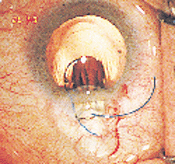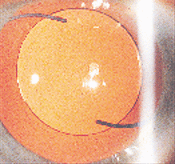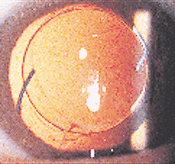Acrylic IOL eliminates folding concerns
With 3 years’ follow-up in a large series of patients the pre-folded MemoryLens is performing well clinically.
 ---The folded MemoryLens is inserted into the incision. There is no stretch of the corneal tissue.
---The folded MemoryLens is inserted into the incision. There is no stretch of the corneal tissue.
Rapid visual recovery and minimal discomfort are the goals of modern cataract surgery. Thanks to the evolution of anesthesiology techniques, with topical anesthesia having the leading edge, and to the development of self-sealing incisions, these goals are easily achievable.
The single parameter most greatly influencing postoperative visual recovery is astigmatism; a well-constructed corneal incision reduces it significantly. Phacoemulsification coupled with foldable IOL implantation allows the use of 3.75- to 4.1-mm sutureless incisions, with minimal induced astigmatism.
At the moment, acrylic IOLs are among the most widely used foldable lenses. Their introduction has solved several problems encountered with silicone IOLs, but time-consuming folding procedures, as well as a firm grasp on the IOL throughout insertion are still necessary. Furthermore, the lens-holding instrument needs to be introduced through the incision, with consequent tissue stretch.
We evaluated a new type of foldable IOL with the capability of overcoming these limitations: the MemoryLens (Mentor Ophthalmics, Santa Barbara, U.S.A.), a three-piece IOL with a biconvex 6 mm optic, and 4-0 polypropylene C-loops angled at 10°.
The MemoryLens optic is made of a copolymer of methylmethacrylate (MMA, a hydrophobic component); 2-HEMA (a hydrophilic component); 4-methacryloxy-2-hydroxy-benzophename (MOPB, the ultraviolet (UV)-filtering component); and ethylene-glycol-dimethacrylate (EGDMA, the molecular chain binding component).
Physical properties
 ---The MemoryLens 1 hour after insertion.
---The MemoryLens 1 hour after insertion.
The physical properties of this copolymer are hydrophilicity (20% water content), UV absorption and a high index of refraction (1.47). This last feature is particularly important, reducing the required thickness for high powers. However, the distinctive feature of the MemoryLens is thermoplasticity. At high temperatures (above 65° C) the lens can be folded, and if rapidly cooled it becomes rigid, maintaining the imparted shape. This is a vitrified status that confers it a consistency comparable to that of PMMA and is maintained up to 25°C, above which the lens spontaneously and gradually recovers its original shape. It is the tri-dimensional structure of the molecular network that allows the lens to maintain "memory" of the original shape.
Thus the MemoryLens, with an optic diameter of 6 mm, can be folded up to a diameter of 2.35 mm, allowing insertion through incisions of 3.5 mm to 4.1 mm. No intraoperative folding procedure is necessary, and the lens can be quietly prepared on the instrument table before the case starts. A few seconds are required to open the lens container and pull it out. The lens maintains its folded shape during insertion, and the holding forceps need not enter the incision. Once in the eye, the lens warms and slowly unfolds. Unfolding at body temperature usually takes place within 90 seconds, a time that can be decreased by using cold infusion fluid or viscoelastic. The MemoryLens features the advantages of foldable IOLs before insertion and those of PMMA once inside the eye.
Evaluation
 ---The MemoryLens 18 months after insertion with visualization of the posterior capsule.
---The MemoryLens 18 months after insertion with visualization of the posterior capsule.
Beginning in February 1995, we evaluated the MemoryLens in 483 cases. The implantation technique used included lateral clear corneal incision, hydrodissection and hydro delineation, phacoemulsification and in-the-bag IOL insertion. Topical anesthesia with 2% lidocaine was used in all cases. Mean surgical time was 11 min 49 sec, and mean ultrasound time was 1 min 55 sec. Immediately postoperative (30 to 120 minutes after surgery), mean visual acuity was 20/40, with mean intraocular pressure (IOP) of 19.6 ± 9.1 mm Hg. (Mean preoperative IOP was 14.9 ± 6.4 mm Hg).
Intraoperative complications included two cases of posterior capsule break (0.41%) and five cases of zonular disinsertion (1.03%). Visual acuity greater than or equal to 20/30 was observed in 85.6% of cases at 1 month, in 77.6% at 1 year and in 76.5% at 2 years. Induced astigmatism at 1 year was less than 1 D in 81%, between 1 D and 2 D in 16.4%, and greater than 2 D in 2.6% of cases. Posterior capsular opacification requiring Nd:YAG laser capsulotomy was noted in 21 cases (4.35%).
Pre-folding is a key advantage of the MemoryLens, leading to reduced operative time. In a similar series of eyes (116 cases) using an acrylic lens, we observed a mean surgical time of 13 min 30 sec.
Once removed from the container and placed at room temperature, the MemoryLens maintains its folded shape for more than 2 minutes. Inside the eye, unfolding is slow and atraumatic, and the central folds disappear within 20 minutes. It is not required to wait for the complete unfolding to complete the surgery. Easy insertion of the IOL is seen using a 4.1-mm incision even for high dioptric powers. A reduction of the "fish mouth" effect caused by the insertion of a large IOL through a small incision, irregular stretch or lacerations of the incision are avoided, maintaining the watertight properties and reducing induced astigmatism. Removal of viscoelastic from under the IOL is facilitated by its folded shape.
It is important to note that the unfolding process is irreversible. Whether at the equator or at the North Pole the MemoryLens will keep its unfolded shape once positioned in the capsular bag.
For Your Information:
- Matteo Piovella, MD, can be reached at Centro Microchirurgia Ambulatoriale, Via Donizetti 24, Monza, 20052, Italy; +(39) 039-389498; fax: +(39) 039-2300964; e-mail: piovella@galactica.it. Dr. Piovella has no direct financial interest in any of the products mentioned in this article. He is a paid consultant for Mentor Ophthalmics.
